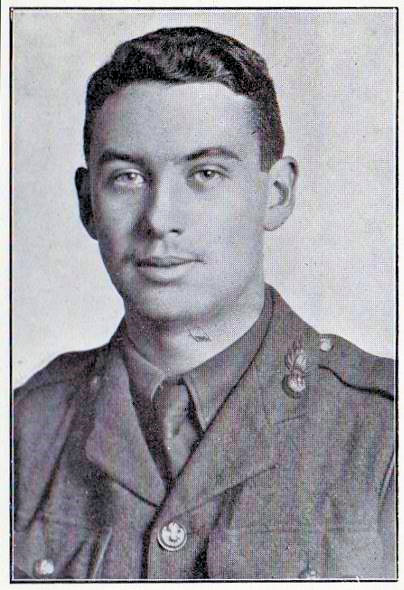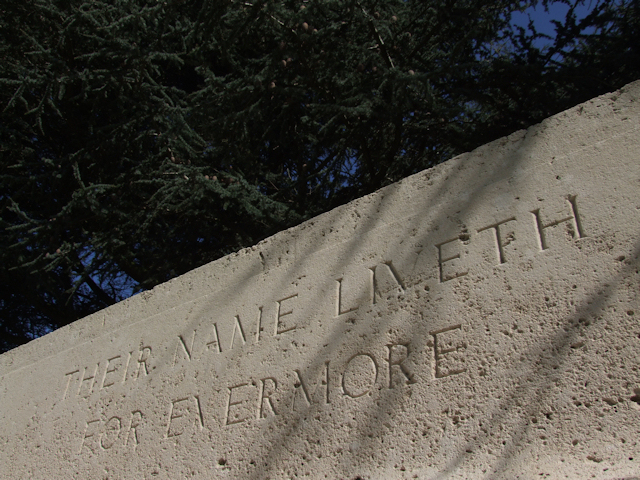Wartime Service
John served in the Manchester University Officers’ Training Corps for four years. He left as a Sergeant, aged 20, with a height of 5’10” and with poor teeth! He applied to be posted to the Royal Flying Corps on 8 December 1914, but presumably this never happened. When war broke out, he applied for a commission and was gazetted on 5 September 1914 as Second Lieutenant to the Royal Scots Fusiliers.
He went to France on 26 January 1915 and, just a few weeks later, was killed in action by a shrapnel shell early in the advance on 10 March at Neuve Chapelle. He was entitled to the Victory, British War and 1914-15 Star medals, his qualifying date being 27 January 1915. The medals were sent to his mother of Watford. He was originally buried at Neuve Chapelle and his body was re-interred [plot IX. C. 30] in 1920 at Guards Cemetry, Windy Corner, Cuincy.
There are articles about John in the Watford Illustrated dated 27 March 1915; and the West Herts. and Watford Observer dated 13 March 1915, 20 March 1915, 10 April 1915 and 10 July 1915.
The National Probate Calendar for 1915 includes to following entry: Moffet John Leison of Ingleside Kingsfield Road Watford Hertfordshire second-lieutenant Royal Scots Fusiliers was killed in action 11 March 1915 in France Administration (with Will) London 31 May to Thomas Moffet surveyor. Effects £156 6s. 3d.
There is an entry for John in Du Ruvigny’s Roll of Honour: "MOFFET, JOHN LEESON, BSc (Hons.) A.M.I.E.E., 2nd Lieu., 3rd Battn. Royal Scots Fusiliers, elder s. of Thomas Moffet, of Ingleside, Kingsfield Road, Watford, Assistant Estate Agent and Land Agent to the London and North-Western Railway Co., Chairman of the Watford Public Library and a member of the Watford District Council, by his wife, Elizabeth Ann, dau. Of the late John Leeson of Rugby ; b. Watford, co. Herts, 17 May, 1888 ; educ. Watford Grammar School, City and Guilds of London Technical College, Finsbury, and Manchester University, where he graduated B.Sc. (Engineering) with honours. On leaving there he became an Engineering Assistant at Horwich Locomotive Works of the Lancashire and Yorkshire Railway Co. and in 1913 left there to take a position as Electrical Expert to the Chloride Electrical Storage and Battery Co., Clifton, Manchester. At Manchester university he had been in the O.T.C. for four years and a half, and had obtained certificates A and B ; on the outbreak of war he applied for a commission and was gazetted 2nd Lieut. to the 3rd Royal Scots Fusiliers, 5 Sept. 1914, and at this date was at Portland in charge of electrical work on a sub-marine. He went to France on 26 Jan. 1915 and was killed in action at Neuve Chapelle, 10 March following ; unm. His Commanding Officer wrote : “He was a most promising officer, keen to learn. He had a high sense of duty and of confidence in himself” ; and another officer: “I last spoke to your son on the morning of March 10 while we were waiting for the artillery bombardment to cease. He was then quite cheery, and certainly not as nervous as a good many of us.” “I was in the same company as your son,” wrote another officer, “and only 10 yards away when he was killed. We had been advancing in extended order just after the capture of the German first line of defence, when we suddenly struck some heavy rifle fire. Your son was in front of me with his platoon, and had just given the order to his men to lie down, when he was struck by a bullet through the left lung and died at once, without speaking. He died a noble death, leading his men into action, and it was through turning round himself to warn his men to take cover that he himself was hit.” Lieut. Moffet was an Associate Member of the Institution of Electrical Engineers, and while training at Greenock received a unanimous invitation to accept the chairmanship of the Manchester Student’s Section of the Institution. He was awarded the Premium Prize of the Institution for a paper on “Possibilities of Electrical Traction on Railways.” His younger brother, Lieut. Thomas Arthur Moffet, Kings Liverpool Regt. Is now (1916) a Railway Transport Officer with the Expeditionary Force in France."
A further obituary is included in the Electrical Engineer WW1 Roll of Honour, 1924: Second Lieutenant J L Moffet, B.Sc. (Tech) (Manchester) 3rd (Reserve) Bn. att. 2nd Bn. The Royal Scots Fusiliers. [see extract included in Before the War section above]
"….and was so employed in August, 1914, when war was declared ; he relinquished his appointment very shortly afterwards, in order to serve in the Army. He enrolled in 1908 in the Manchester Officers’ Training Corps as a Cadet, and served in it for three years, being one of the very active members of the Corps. He obtained Certificates A and B, and thus became qualified for a Commission in the Special Reserve. On the declaration of war, he at once offered his services to the military authorities, and expressed his readiness to serve in the Army in any capacity. He was gazetted to a Commission (dating as from August 15) on September 8, 1914, and posted to the 3rd (Reserve) Battalion The Royal Scots Fusiliers, which at the time formed part of the garrison of the defended port of the Clyde. He joined his Battalion at Greenock, Scotland, and was for about five months engaged there on Coast Defence duties. He was ordered to the front in early 1915, and crossed to France on January 26. He was then attached to the 2nd Battalion of the Regiment, which at the time was one of the battalions of the 21st Infantry Brigade of the famous 7th Division. The Battalion had behaved most gallantly on October 31, 1914, and was practically annihilated, whilst devotedly covering the left flank of its Division, which had become exposed during its attack on Gheluvelt, owing to the sudden retirement of the 1st Division. His arrival at the Front synchronized with a revival of activity on the part of the enemy after the lull which had followed upon the severe fighting of the late Autumn of 1914. When he joined his new unit, his Division was in charge of the IV Corps, which was then in the area of the First Army (on the southern portion of the British Line) and lay with the III Corps on its left and the Indian Corps on its right ; the left flank of the Indian Corps rested at the time at Neuve Chapelle. New formations were now arriving at the Front and were either fitted into the existing Corps of the First and Second Armies, or were allotted to the Third Army then in process of formation. With the arriving of spring and the drying of the water-soaked fields of Flanders, preparations were taken in hand for an offensive campaign. The British Commander-in-Chief decided to deliver his first blow against Neuve Chapelle, a village which had changed hands several times during the fighting in 1914, and, at the end of October, when the struggle died down, had remained in German hands. The troops chosen for the assault were those of the IV Corps ; they were to operate on the left, whilst the Indian Corps attacked on the right. The Second Army was at the same time to demonstrate with sufficient energy to hold the Germans and to prevent them from sending reinforcements to their comrades in the positions opposite the southern section of the British line. The I Corps had also received instruction to make a strong feint in the neighbourhood of Givenchy. Further to hinder reinforcements being moved from reserve in the northern towns behind the German fighting line, the British airmen were directed to attack the sections of the railway along which troops could be conveyed by train to the front trenches ; Menin, Courtrai, Don and Douai thus became objectives which received considerable attention at the hands of the pilots of the Royal Flying Corps. March 10, 1915, was the date named for launching the attack (Battle of Neuve Chapelle – March 10-13). The front upon which the assault was to be delivered was some half-mile in extent, and stretched from a point near Aubers to Richebourg l’Avoué ; his Division was on the left front of the IV Corps and had the 8th Division on its right. On the first day, the brunt of the fighting fell upon the 8th Division and the Indian Corps ; his Brigade was the only infantry of his Division which was actively employed on that day. At 7.30 the British guns began to boom ; at 8.5am they suddenly ceased fire, and the Infantry of the assaulting Divisions went “over the top.” Later, the word was given and his Brigade, on the extreme left of the advance, pushed onwards with fierce impetuosity in an attack, which was an extension, on the left, of the original advance. There is a hamlet to the north-east of Neuve Chapelle called Moulin du Piètre, and this was the immediate objective of his Brigade. Several hundred yards were gained before the advance was checked by a galling fire from the houses of the hamlet ; a line of fresh undamaged German trenches was now discovered opposite the right front of his Brigade, which was, in consequence, held up here until the evening. The enemy was very active ; his Brigade however, stubbornly resisted all attempts to push it back. The 8th Division had advanced upon the right of his Brigade ; its 23rd Infantry Brigade was decimated by the searching fire from the German trenches, and its place was taken by the 24th Brigade of the same Division, but it also was brought to a halt by the fire of the enemy machine-guns. During the advance of his Brigade, whilst he was gallantly leading his Platoon on to the German second line position, he came under the fire of well posted machine-guns ; he was hit by a bullet which pierced his left lung and killed him instantaneously. Age 26 10 Months. Unmarried. [The obituary then includes the officer quotes given in the extract from Du Ruvigny’s Roll of Honour above.]"



